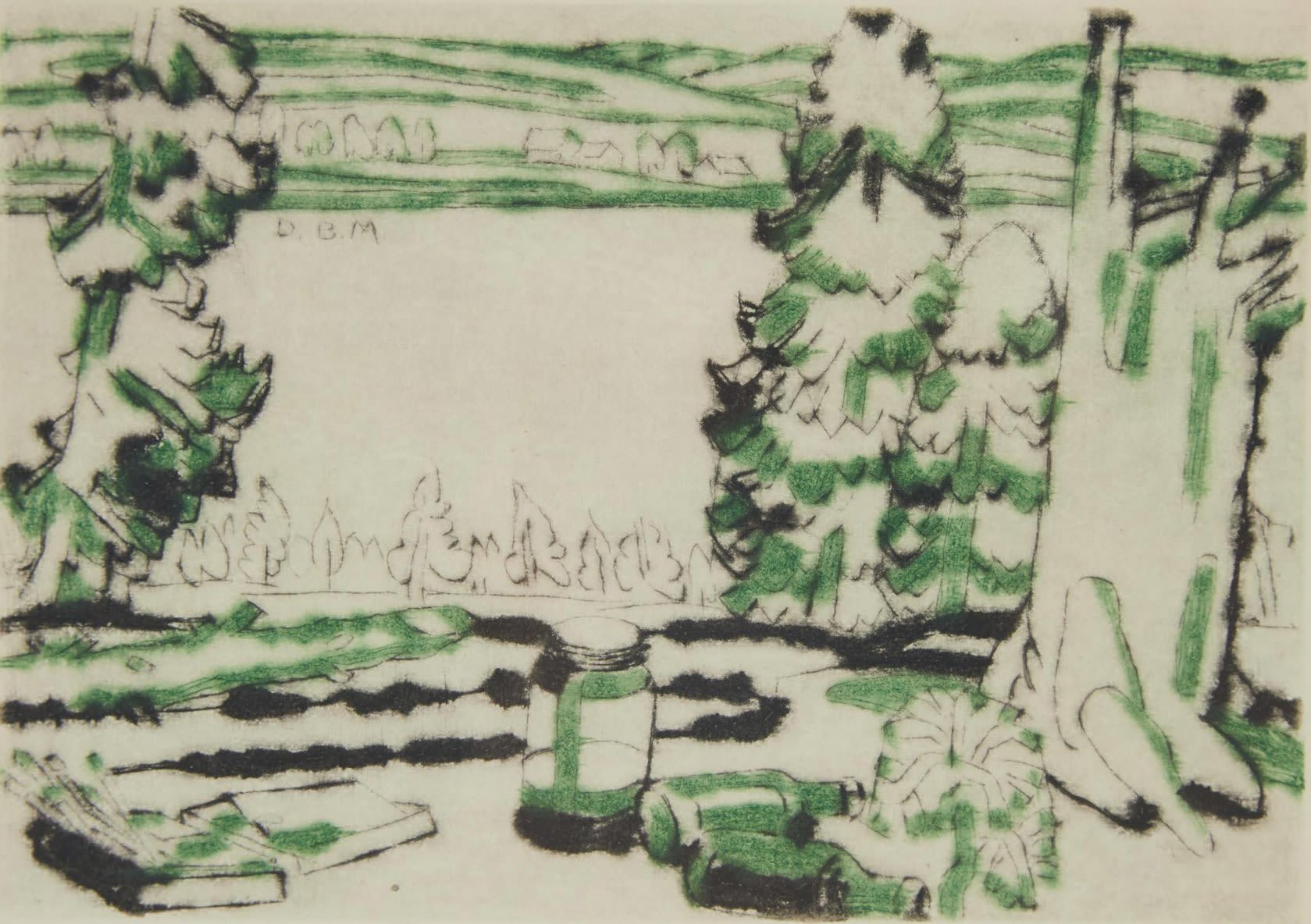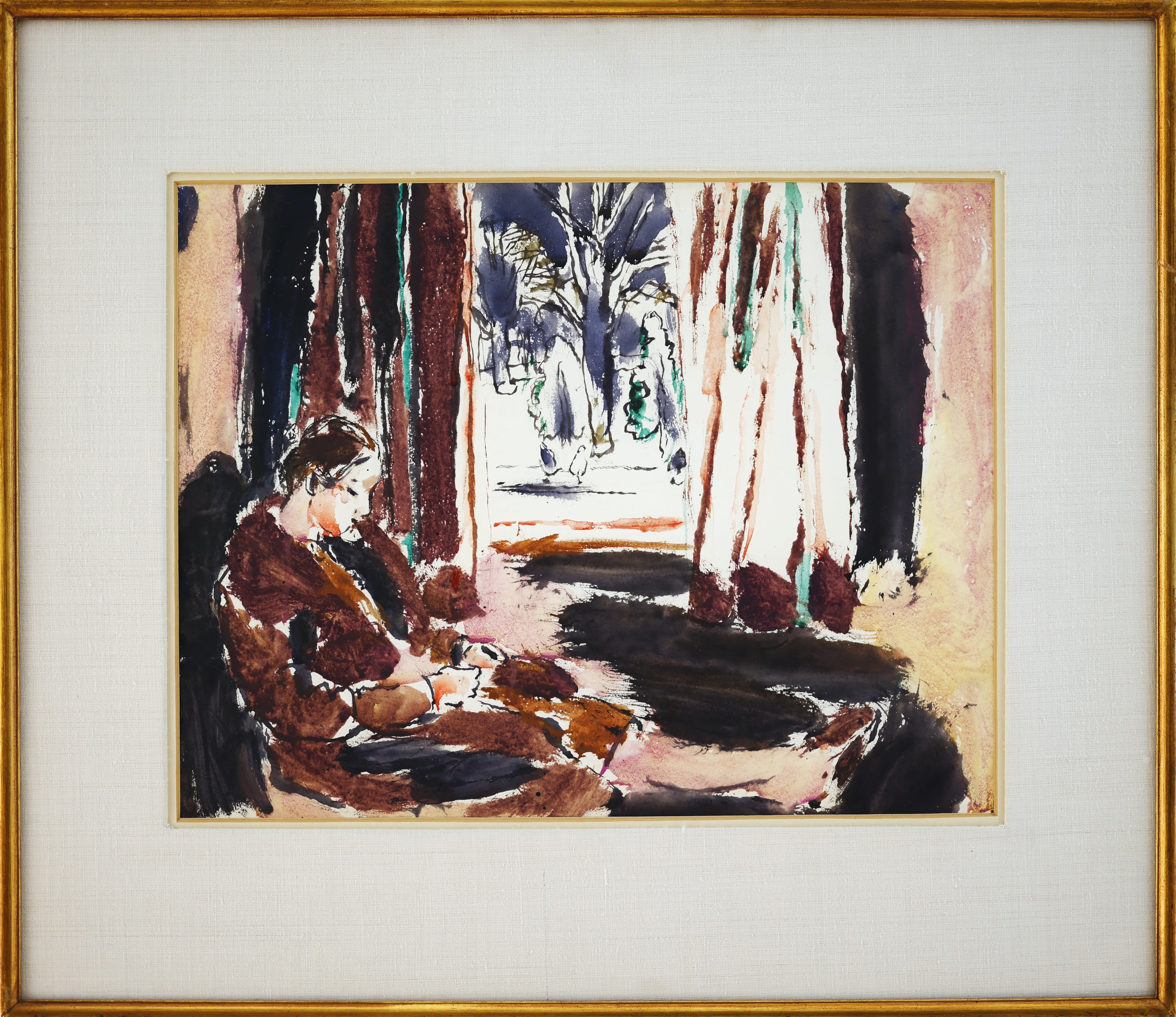“I didn’t even see the hepaticas. I saw instead an arrangement of lines, spaces, hues, values and relations … I saw one of my own pictures, a little different from ones done before.”
David Brown Milne (8 January 1882 – 26 December 1953) was a pioneering Canadian painter, printmaker, and writer whose refined minimalism and modernist vision distinguished him from contemporaries such as Tom Thomson and the Group of Seven. Often called the Master of Absence for his ability to reduce a scene to its essentials, Milne forged a uniquely Canadian modernism that blended European influences with an intensely personal interpretation of nature.

David Milne; Black Waterfall
Born near Paisley, Ontario, the youngest of ten children of Scottish immigrants, Milne showed artistic talent early and initially taught in a country school before taking a correspondence art course. In 1903, at the age of twenty-one, he moved to New York City to study at the Art Students’ League, absorbing Impressionism, Post-Impressionism, and Fauvism through the city’s galleries and lectures by Robert Henri and William Chase. His early exposure to modernism at Stieglitz’s Gallery 291 and the Durand-Ruel Gallery profoundly shaped his style.

David Milne; Billboards
By 1913, Milne’s work had earned a place among the avant-garde: he was one of only two Canadians featured in the legendary Armory Show in New York, exhibiting alongside Matisse, Cézanne, Picasso, and Brancusi. Two years later, his paintings were shown at the Panama-Pacific International Exposition in San Francisco. He was represented by the N.E. Montross Gallery, which also exhibited members of the Ashcan School.
Milne married Frances “Patsy” Hagerty in 1912, and the couple settled in Boston Corners, New York, where his quiet surroundings inspired a distinctive body of landscape and still-life paintings. In 1917, Milne enlisted in the Canadian Army and served in England during the final months of the First World War, later completing a series of haunting war paintings for the Canadian War Memorials Fund depicting camps and deserted battlefields in France and Belgium.
 David Milne; Bomb Crater behind Vimy Station
David Milne; Bomb Crater behind Vimy Station
After the war, Milne spent a decade in rural New York before returning to Canada in 1929, living successively in Temagami, Weston, Palgrave, Six Mile Lake, and Uxbridge, Ontario. Each move brought a shift in palette, form, and theme. He sought solitude, painting almost daily in makeshift cabins surrounded by the Ontario wilderness. Although he admired Tom Thomson’s artistry, Milne rejected the overt nationalism of the Group of Seven, focusing instead on “pure painting” — what he called adventures in shape, colour, texture, and space.
Milne’s art, informed by Monet’s unity of colour and Matisse’s simplification of form, distilled ordinary subjects — barns, trees, flowers, towns, and lakes — into compositions of striking restraint. He used white not as absence but as a positive element of design, and his frequent contrasts of black and white created a visual tension that defined his style.
 David Milne; Reflected Forms
David Milne; Reflected Forms
An experimental printmaker, Milne developed an innovative method of colour drypoint etching, layering different hues on multiple plates to achieve delicately modulated results. His works in this medium are now regarded as among the most accomplished in Canadian printmaking.
 David Milne; Painting Place
David Milne; Painting Place
In the late 1930s, Milne met Kathleen Pavey, a nurse who became his lifelong partner; their son, David Jr., was born in 1941. This new domestic chapter inspired a lyrical shift in his work: whimsical still lifes, Biblical reinterpretations, and the celebrated fantasy watercolours of his later years.

David Brown Milne; Winter Coat
Critical recognition grew steadily after Vincent and Alice Massey began collecting his work in the 1930s and introduced him to gallerist Douglas Duncan, who became his champion and dealer. Eminent critic Clement Greenberg later ranked Milne among the three greatest North American artists of his generation, alongside John Marin and Marsden Hartley. A.Y. Jackson called him “a genius.”
Milne represented Canada at the 1952 Venice Biennale with Emily Carr, Goodridge Roberts, and Alfred Pellan. After his death in Bancroft, Ontario, in 1953 following a series of strokes, the National Gallery of Canada mounted major retrospectives of his work (1955–56 and 1962). His legacy has continued to grow through later exhibitions such as David Milne Watercolours: Painting Toward the Light (British Museum, Metropolitan Museum of Art, and Art Gallery of Ontario, 2005) and the 2018 Dulwich Picture Gallery survey in London.
 David Brown Milne; Sports Arena, Bancroft
David Brown Milne; Sports Arena, Bancroft
Milne’s lifetime production includes roughly 3,000 paintings and an equal number of drawings and prints, divided almost evenly between oil and watercolour. His work is represented in major institutions including the National Gallery of Canada, Art Gallery of Ontario, McMichael Canadian Art Collection, and Winnipeg Art Gallery.
Throughout his career, Milne’s writings and journals paralleled his art — thoughtful, humorous, and fiercely introspective meditations on the creative process. For Milne, painting was the only thing that mattered. His lifelong quest to express essence rather than appearance secured his place as one of Canada’s most original and enduring modernists.



